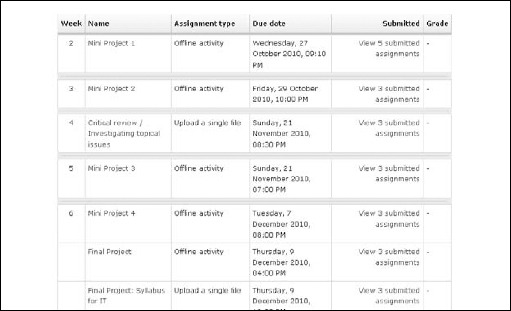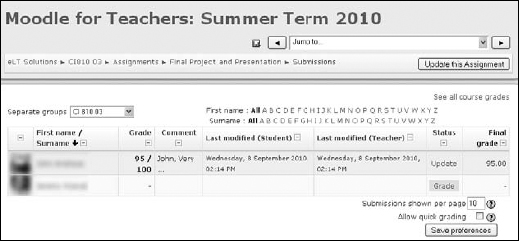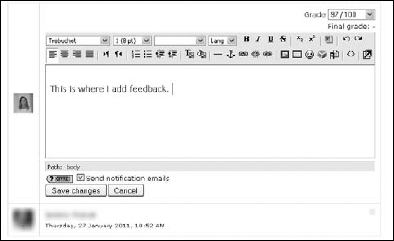Administering Assignment Submissions
Only a few administrative tasks are involved with assignment submissions and upkeep. Moodle adds useful functionality for you to view submissions. When you're ready to mark and/or comment on students work, the following tools make your job easier.
- Viewing students' submissions: You can view student's submissions in two ways. You can click the Assignment link in the Activities block, and Moodle takes you to a table that lists all the assignments by week/topic assigned, tells you what type the assignment is, states the due date, and tells how many were submitted and what the grades are. (See Figure 10-3.) This is a very useful overview. Each assignment name is a link that takes you to that specific assignment. If you click the View X Submitted Assignments link, Moodle takes you to an Assignment Submissions page like the one shown in Figure 10-4.
Another way to access the assignment is from the course front page. By clicking the name of the individual assignment, Moodle takes you to new page listing the assignment description and another link in top-right corner informing you how many assignments have been submitted. Select this link by clicking it. Moodle takes you to the Assignment Submissions page like the one shown in Figure 10-4. Notice this page is set up as a table with headings First Name/Surname; Grade; Comment; Last Modified (Student); Last Modified (Teacher); and Status. You can sort the list by clicking the heading.
Figure 10-3: A table that details all assignments.

Figure 10-4: The Assignment Submissions page.

- Grading students' submissions: To grade a submission, click the Grade button in the Status column on the right. (See Figure 10-4.) Moodle takes you to the Student's Assignment Grade and Feedback page, as shown in Figure 10-5. The look and feel of the feedback page and links are identical for all assignment types with slight differences to compensate for the diversity of functionality.
- • Upload a Single File and Advanced Uploading of Files: The main difference is that you have a link to access the uploaded document located in the bottom-right corner. If it's a Web page, you can open it in the browser. A Word document also opens, but if you want to make comments, you need to save it to your hard drive. For Advanced Uploading of Files, you also can use a response file to give students feedback. When students are finished with the final document, they click Submit for Marking.
- • Online Text: You can view the submission in a separate box with the word count located above. If you've enabled the inline comment option when setting up the assignment, Moodle copies the text into the feedback comment box.
Figure 10-5: The Assignment Grade and Feedback page.

When you finish reviewing and commenting on the assignments, choose the grade from the drop-down list located in the top-left corner, add comments in the comments box, and select the Save Changes or Save Changes and Show Next button.
![]() Two more neat functionalities are located in the grade window. If you want to grade multiple assignments, all on the same page, select the Allow for Quick Grading check box in the bottom left of the assignment Submissions page. All you need to do is add grades and make comments and then click the Save All My Feedback button. Remember that you can access students' profiles by clicking their names, which may be useful if you want to add a note, as discussed in Chapter 8.
Two more neat functionalities are located in the grade window. If you want to grade multiple assignments, all on the same page, select the Allow for Quick Grading check box in the bottom left of the assignment Submissions page. All you need to do is add grades and make comments and then click the Save All My Feedback button. Remember that you can access students' profiles by clicking their names, which may be useful if you want to add a note, as discussed in Chapter 8.
All assignment types have the Grade drop-down list located in the top-right corner. Below the drop-down list, Moodle tells you whether the grade is final. The textbox is very useful for feedback and to highlight any aspect of the project or assignment. Below the feedback text area, select the check box if you want the learner notified by e-mail that the assignment has been graded. This is useful if you're giving feedback on drafts of an assignment. At the bottom, you have four buttons: Save Changes, Cancel, Save and Show Next, and Next. The first two buttons are self-explanatory; the latter two each take you to the next learner in your class list.
